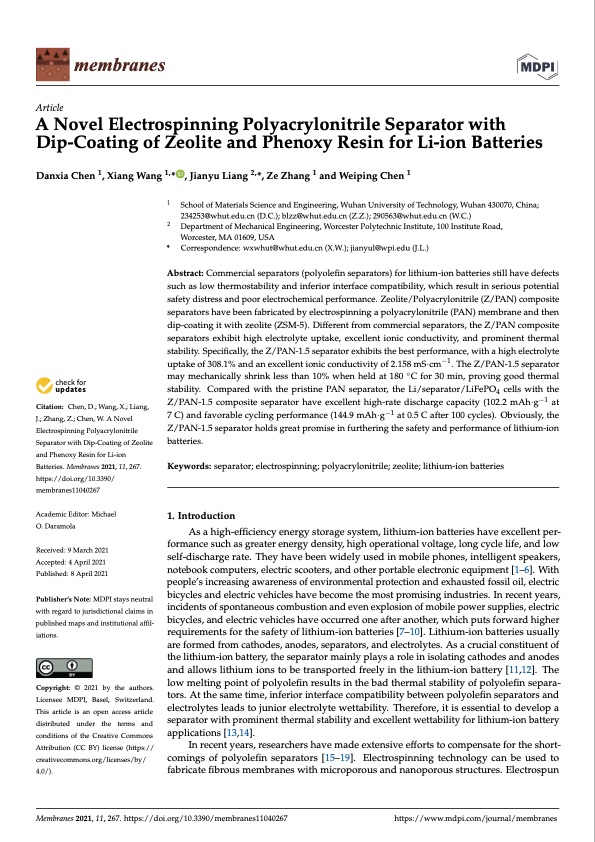
PDF Publication Title:
Text from PDF Page: 001
Abstract: Commercial separators (polyolefin separators) for lithium-ion batteries still have defects such as low thermostability and inferior interface compatibility, which result in serious potential safety distress and poor electrochemical performance. Zeolite/Polyacrylonitrile (Z/PAN) composite separators have been fabricated by electrospinning a polyacrylonitrile (PAN) membrane and then dip-coating it with zeolite (ZSM-5). Different from commercial separators, the Z/PAN composite separators exhibit high electrolyte uptake, excellent ionic conductivity, and prominent thermal stability. Specifically, the Z/PAN-1.5 separator exhibits the best performance, with a high electrolyte uptake of 308.1% and an excellent ionic conductivity of 2.158 mS·cm−1. The Z/PAN-1.5 separator may mechanically shrink less than 10% when held at 180 ◦C for 30 min, proving good thermal stability. Compared with the pristine PAN separator, the Li/separator/LiFePO4 cells with the Z/PAN-1.5 composite separator have excellent high-rate discharge capacity (102.2 mAh·g−1 at 7 C) and favorable cycling performance (144.9 mAh·g−1 at 0.5 C after 100 cycles). Obviously, the Z/PAN-1.5 separator holds great promise in furthering the safety and performance of lithium-ion batteries. Keywords: separator; electrospinning; polyacrylonitrile; zeolite; lithium-ion batteries 1. Introduction As a high-efficiency energy storage system, lithium-ion batteries have excellent per- formance such as greater energy density, high operational voltage, long cycle life, and low self-discharge rate. They have been widely used in mobile phones, intelligent speakers, notebook computers, electric scooters, and other portable electronic equipment [1–6]. With people’s increasing awareness of environmental protection and exhausted fossil oil, electric bicycles and electric vehicles have become the most promising industries. In recent years, incidents of spontaneous combustion and even explosion of mobile power supplies, electric bicycles, and electric vehicles have occurred one after another, which puts forward higher requirements for the safety of lithium-ion batteries [7–10]. Lithium-ion batteries usually are formed from cathodes, anodes, separators, and electrolytes. As a crucial constituent of the lithium-ion battery, the separator mainly plays a role in isolating cathodes and anodes and allows lithium ions to be transported freely in the lithium-ion battery [11,12]. The low melting point of polyolefin results in the bad thermal stability of polyolefin separa- tors. At the same time, inferior interface compatibility between polyolefin separators and electrolytes leads to junior electrolyte wettability. Therefore, it is essential to develop a separator with prominent thermal stability and excellent wettability for lithium-ion battery applications [13,14]. In recent years, researchers have made extensive efforts to compensate for the short- comings of polyolefin separators [15–19]. Electrospinning technology can be used to fabricate fibrous membranes with microporous and nanoporous structures. Electrospun membranes Article A Novel Electrospinning Polyacrylonitrile Separator with Dip-Coating of Zeolite and Phenoxy Resin for Li-ion Batteries Danxia Chen 1, Xiang Wang 1,* , Jianyu Liang 2,*, Ze Zhang 1 and Weiping Chen 1 School of Materials Science and Engineering, Wuhan University of Technology, Wuhan 430070, China; 234253@whut.edu.cn (D.C.); blzz@whut.edu.cn (Z.Z.); 290563@whut.edu.cn (W.C.) Department of Mechanical Engineering, Worcester Polytechnic Institute, 100 Institute Road, Worcester, MA 01609, USA Correspondence: wxwhut@whut.edu.cn (X.W.); jianyul@wpi.edu (J.L.) Citation: Chen,D.;Wang,X.;Liang, J.; Zhang, Z.; Chen, W. A Novel Electrospinning Polyacrylonitrile Separator with Dip-Coating of Zeolite and Phenoxy Resin for Li-ion Batteries. Membranes 2021, 11, 267. https://doi.org/10.3390/ membranes11040267 Academic Editor: Michael O. Daramola Received: 9 March 2021 Accepted: 4 April 2021 Published: 8 April 2021 Publisher’s Note: MDPI stays neutral with regard to jurisdictional claims in published maps and institutional affil- iations. Copyright: © 2021 by the authors. Licensee MDPI, Basel, Switzerland. This article is an open access article distributed under the terms and conditions of the Creative Commons Attribution (CC BY) license (https:// creativecommons.org/licenses/by/ 4.0/). 1 2 * Membranes 2021, 11, 267. https://doi.org/10.3390/membranes11040267 https://www.mdpi.com/journal/membranesPDF Image | Electrospinning Polyacrylonitrile Separator with Dip-Coating of Zeolite

PDF Search Title:
Electrospinning Polyacrylonitrile Separator with Dip-Coating of ZeoliteOriginal File Name Searched:
membranes-11-00267.pdfDIY PDF Search: Google It | Yahoo | Bing
CO2 Organic Rankine Cycle Experimenter Platform The supercritical CO2 phase change system is both a heat pump and organic rankine cycle which can be used for those purposes and as a supercritical extractor for advanced subcritical and supercritical extraction technology. Uses include producing nanoparticles, precious metal CO2 extraction, lithium battery recycling, and other applications... More Info
Heat Pumps CO2 ORC Heat Pump System Platform More Info
| CONTACT TEL: 608-238-6001 Email: greg@infinityturbine.com | RSS | AMP |